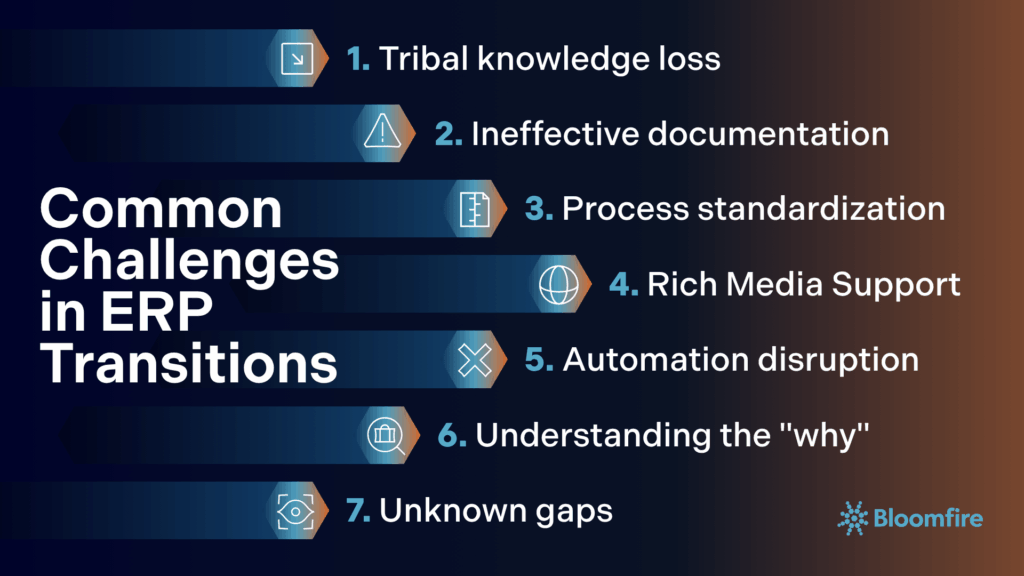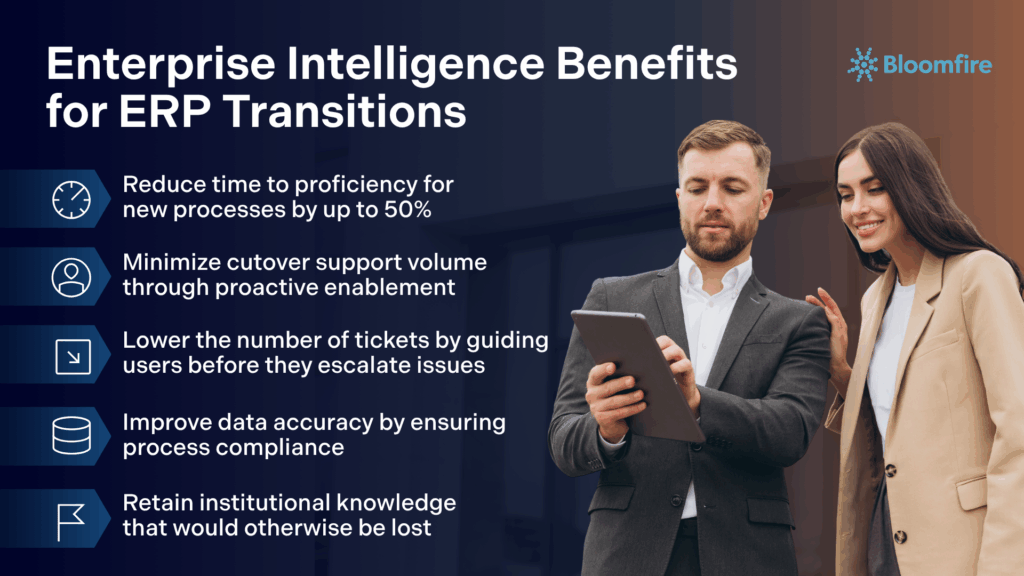ERP Transitions Without the Chaos: How Bloomfire and Enterprise Intelligence Reduce Change Friction

ERP transitions are among the most high-stakes initiatives a company can undertake. Whether shifting to SAP S/4HANA, Workday, or Oracle Cloud, these systems touch nearly every process in the business. Yet too often, ERP transitions spiral into disjointed chaos.
Beyond the well-known ERP challenges—cost overruns, delayed launches, and user resistance—there lies a subtler but equally potent risk: knowledge transfer. The knowledge required to help employees adapt is often inadequately documented, training is insufficiently deployed, and process changes often render tried-and-true methods obsolete. This results in employees who lack engagement and ownership in the transition, drains productivity, and compromises the project’s success.
So how do you de-risk an ERP system implementation and speed up time-to-proficiency? It starts with understanding where traditional approaches fall short—and why Enterprise Intelligence is essential.
Common Challenges in ERP Transitions
ERP change management isn’t just about introducing new software; it’s about guiding people through operational modernization. And that’s where many efforts stumble:
- Tribal knowledge loss: Process shifts wipe out undocumented workarounds and exceptions that employees rely on.
- Ineffective documentation: New processes are often inconsistently documented, difficult to find, or lack the versatility to adapt to real-world situations
- Process standardization: ERP implementations eliminate local exceptions, forcing teams to relearn new, standardized processes. New shortcuts aren’t easily shared when found.
- Automation disruption: Manual processes become obsolete, yet aren’t replaced with accessible alternatives.
- Understanding the why: Training often focuses on what needs to be done, rather than why changes were made or how the new process will improve results.
- Change fatigue: Without adequate enablement, employees get overwhelmed and revert to “old ways” or worse, disengage and become less productive.
- Unknown gaps: Leaders lack visibility into which resources employees truly need to adapt, a challenge often rooted in the absence of effective company-wide knowledge management systems.

These ERP implementation risks often compound over time, manifesting as prolonged ramp-up periods, increased support tickets, and missed value milestones.
And when support teams are overwhelmed by basic questions or repeated training requests, it’s not just frustrating—it’s expensive. Every time an employee asks, “How do I do this now?” and waits for a response, your transition timeline stretches, and productivity stalls.
How Parts Town Nailed Their ERP
See how Parts Town used Bloomfire to streamline knowledge during ERP rollout.
Read MoreWhy Traditional Methods Fall Short
The go-to tactics for ERP change management—job-aids, work instructions, slide decks, SharePoint folders, one-off trainings—weren’t designed for dynamic transitions:
- Job aids relying on system images can become outdated within weeks.
- Static wikis fail to surface “how do I do this now?” answers in real time.
- Mass emails bury crucial updates.
- Large training sessions often focus on the lowest common denominators and fail to address process exceptions adequately.
- Tacit knowledge is lost when SMEs move on or burnout.
- Users lack a consistent system of record to validate process changes.
In high-velocity ERP transitions, these tools simply don’t keep up. What’s needed is a living, intelligent knowledge ecosystem that adapts as fast as your business does.
Enterprise Intelligence: Supporting Modernization During Transitions
ERP transitions are not just system upgrades—they’re modernization mandates. Enterprise Intelligence aligns directly with this mission by addressing both the structural and human sides of change.
- Connecting Knowledge Pools: Bloomfire centralizes SOPs, process maps, exception handling rules, and change documentation, making them easily searchable and permissioned across departments.
- Self-Healing Knowledge Base: Outdated references to legacy processes are flagged and replaced, reducing the spread of conflicting or obsolete information. A single source of truth ensures dynamic changes are pushed to all users simultaneously.
- Unlocking Tacit Knowledge: Peer insights, power-user tips, and shortcuts are captured through comments, Q&A, and SME-authored posts.
- Injecting Knowledge into the Flow of Work: Bloomfire integrates directly into the ERP help center, delivering relevant content exactly where adoption friction occurs.
- Proactively Surfacing Insights: AI highlights recently changed processes and updates, helping users understand what’s different and why.
Together, these principles reduce friction, smooth the knowledge transfer process, and establish a stronger foundation for ERP adoption. These capabilities reflect the core principles of Enterprise Intelligence—an approach designed to surface real-time knowledge and reduce friction at scale.
How Bloomfire Helps Teams Adapt to Broken Shortcuts
The hard reality of ERP transitions? Users can no longer “just bypass” steps. System-enforced workflows make old shortcuts impossible.
Here’s how Bloomfire eases that shift:
- Create “Before and After” Guides: Visualize legacy versus new processes to help employees quickly reorient themselves.
- Dynamic FAQs: Capture and update questions like “How do I handle X exception now?” with verified, searchable answers.
- Peer-Contributed Workarounds: Power users share approved tips that help others navigate the new landscape.
- Versioned SOPs: Keep instructions current while retaining access to historical guidance for context.
- Make all this documentation easily accessible via Intelligent Search, Ask AI, and direct ERP system integrations.
“We spent months preparing for the ERP system switch by training employees to use Bloomfire as our single source of truth. The result? A smooth crossover and recognition from leadership on how well it went.”
This approach doesn’t just reduce errors—it increases confidence and fosters a culture of shared learning.
Benefits for ERP Transitions
Enterprise Intelligence isn’t theoretical. It delivers measurable outcomes that accelerate your ERP ROI:
- Reduce time to proficiency for new processes by up to 50%
- Minimize cutover support volume through proactive enablement
- Lower the number of tickets by guiding users before they escalate issues
- Improve data accuracy by ensuring process compliance
- Retain institutional knowledge that would otherwise be lost

By shifting from static documents to adaptive knowledge flows, organizations dramatically reduce the operational drag of ERP transitions.
These outcomes aren’t just theoretical—they’re backed by Bloomfire customer data, featured in the Value of Enterprise Intelligence report. In one recent implementation across a global enterprise, Bloomfire helped reduce ERP-related support tickets by 40% in the first three months post-go-live. Faster access to curated process knowledge helped teams adjust quickly and confidently.
Practical Steps for Using Bloomfire During ERP Transitions
Bloomfire is more than a repository—it’s an activation layer for knowledge. Here’s how teams use it during ERP transitions:
- Capture process changes live: Record walkthroughs, annotate process maps, and publish them as searchable posts.
- Organize knowledge by role and workflow: Create series for each department, tagging content for relevance and visibility.
- Leverage Ask AI: Automatically deflect repetitive questions and route users to accurate content.
- Track engagement: Monitor what’s being viewed, what’s being missed, and where knowledge gaps exist.
This turns your ERP change management strategy into a living, evolving system that meets users where they are.
Future-Proof Your ERP Investment
An ERP transition is a catalyst for change. It doesn’t just install new software—it exposes inefficiencies, retires shortcuts, and demands modernization. But without intentional knowledge enablement, these transitions create more friction than forward motion.
A purpose-built knowledge management platform bridges the gap between change strategy and daily execution. It empowers teams to move faster, learn continuously, and adapt confidently.
If you’re leading an ERP transition, don’t let knowledge be your blind spot. Instead, make it your competitive edge.
Simplify ERP Change. Accelerate Value.
Schedule a demo to see how Bloomfire can simplify your ERP transition.
Take a Test Drive

Enterprise AI Search: Definition, Benefits, and Evolution

The Benefit of Company-Wide Knowledge Management in 2026

Are You Making These Common Knowledge Sharing Mistakes?

Estimate the Value of Your Knowledge Assets
Use this calculator to see how enterprise intelligence can impact your bottom line. Choose areas of focus, and see tailored calculations that will give you a tangible ROI.

Take a self guided Tour
See Bloomfire in action across several potential configurations. Imagine the potential of your team when they stop searching and start finding critical knowledge.
